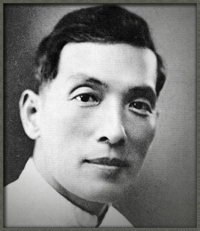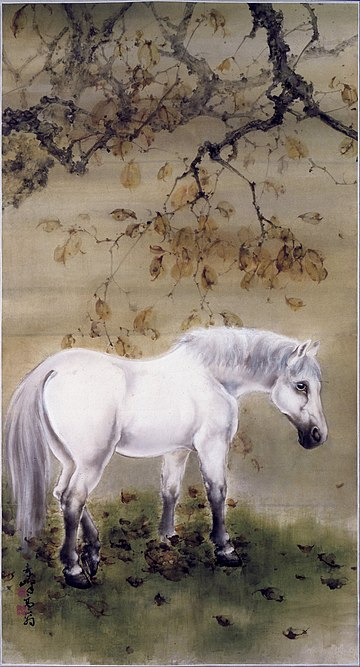Gao Qifeng, a prominent Chinese painter, significantly impacted modern Chinese artChinese art encompasses a vast array of forms and influences. It has a rich history that dates back over 5,000 years and is characterized by unique regional, philosophical, and political influences that have evolved over millennia. Ancient Era The origins of Chinese art trace back to prehistoric times, highlighted by significant archaeological discoveries. These findings include pottery, jade carvings, and More through his innovative blend of traditional techniques and modern sensibilities. Known for his evocative depictions of animals and nature, Gao’s work bridges the gap between classical Chinese paintingPainting is a fundamental form of visual art that has been practiced for thousands of years. It involves applying pigment to a surface such as canvas, paper, or a wall. Painting can be explored through various styles, techniques, and mediums, each offering unique possibilities for expression and creativity. Historical Background • Ancient Beginnings: The history of painting dates back to More and contemporary art.
Early Life and Education
Born in 1889 in Panyu, Guangdong province, Gao Qifeng came from a family of artists. His older brother, Gao Jianfu, was also a notable painter and played a significant role in his artistic development. Gao Qifeng studied under the famous painter Ju Lian and later attended the Tokyo School of Fine Arts in Japan, where he was exposed to Western art forms.
- Birth: 1889, Panyu, Guangdong province
- Education: Tokyo School of Fine Arts, Japan
- Influences: Ju Lian (mentor), Gao Jianfu (brother)

Artistic Development
In Japan, Gao Qifeng absorbed Western artistic techniques and integrated them with his traditional Chinese training. This fusion allowed him to develop a unique style that resonated with both Eastern and Western audiences. His exposure to Japanese Nihonga paintingPainting is a fundamental form of visual art that has been practiced for thousands of years. It involves applying pigment to a surface such as canvas, paper, or a wall. Painting can be explored through various styles, techniques, and mediums, each offering unique possibilities for expression and creativity. Historical Background • Ancient Beginnings: The history of painting dates back to More also influenced his approach, emphasizing detailed brushworkMasterful brushwork is often the defining feature of great artists, where the brush becomes an extension of their arm, allowing paint to flow effortlessly onto the canvas. These artists demonstrate a profound understanding of their medium, knowing precisely when to apply thick, textured strokes or smooth, delicate ones. Their skill extends beyond mere color application; it's about the artistry of More and harmonious compositions.
Key Influences
- Mentors: Ju Lian, Gao Jianfu
- Styles: Japanese Nihonga, Western techniques
Style and Technique
Gao Qifeng’s works are characterized by their meticulous detail and vibrant use of color. His paintings often feature animals, especially birds and horses, capturing their essence with a blend of realismRealism is an art movement that emerged in the mid-19th century, emphasizing the depiction of subjects as they appear in everyday life. It rejects the idealized forms and dramatic expressions of Romanticism, focusing instead on accuracy, truthfulness, and the mundane aspects of the human experience. Realism strives to capture the world in a straightforward and unembellished manner. Gustave Courbet, The More and traditional Chinese artistic principles. Gao’s brushworkMasterful brushwork is often the defining feature of great artists, where the brush becomes an extension of their arm, allowing paint to flow effortlessly onto the canvas. These artists demonstrate a profound understanding of their medium, knowing precisely when to apply thick, textured strokes or smooth, delicate ones. Their skill extends beyond mere color application; it's about the artistry of More is precise and controlled, reflecting his deep understanding of traditional Chinese paintingPainting is a fundamental form of visual art that has been practiced for thousands of years. It involves applying pigment to a surface such as canvas, paper, or a wall. Painting can be explored through various styles, techniques, and mediums, each offering unique possibilities for expression and creativity. Historical Background • Ancient Beginnings: The history of painting dates back to More techniques.
- Detail: Meticulous and vibrant
- Subjects: Animals, especially birds and horses
- BrushworkMasterful brushwork is often the defining feature of great artists, where the brush becomes an extension of their arm, allowing paint to flow effortlessly onto the canvas. These artists demonstrate a profound understanding of their medium, knowing precisely when to apply thick, textured strokes or smooth, delicate ones. Their skill extends beyond mere color application; it's about the artistry of More: Precise and controlled

Major Works
Some of Gao Qifeng’s most notable works include “Woodpecker” and “Horse.” These paintings exemplify his skill in capturing the delicate details of fur and feathers, blending traditional themes with modern techniques to create works that are both timeless and contemporary.
Notable Pieces
- “Woodpecker”: Detailed depiction of a woodpecker in its natural habitat
- “Horse”: Elegant portrayal of a horse, capturing its strength and grace

Contributions to Modern Chinese Art
Gao Qifeng played a crucial role in the Lingnan School of paintingPainting is a fundamental form of visual art that has been practiced for thousands of years. It involves applying pigment to a surface such as canvas, paper, or a wall. Painting can be explored through various styles, techniques, and mediums, each offering unique possibilities for expression and creativity. Historical Background • Ancient Beginnings: The history of painting dates back to More, which sought to modernize Chinese artChinese art encompasses a vast array of forms and influences. It has a rich history that dates back over 5,000 years and is characterized by unique regional, philosophical, and political influences that have evolved over millennia. Ancient Era The origins of Chinese art trace back to prehistoric times, highlighted by significant archaeological discoveries. These findings include pottery, jade carvings, and More by incorporating Western techniques and perspectives. His contributions helped pave the way for future generations of artists, fostering a more global approach to Chinese paintingPainting is a fundamental form of visual art that has been practiced for thousands of years. It involves applying pigment to a surface such as canvas, paper, or a wall. Painting can be explored through various styles, techniques, and mediums, each offering unique possibilities for expression and creativity. Historical Background • Ancient Beginnings: The history of painting dates back to More.
- Role: Leader in the Lingnan School of paintingPainting is a fundamental form of visual art that has been practiced for thousands of years. It involves applying pigment to a surface such as canvas, paper, or a wall. Painting can be explored through various styles, techniques, and mediums, each offering unique possibilities for expression and creativity. Historical Background • Ancient Beginnings: The history of painting dates back to More
- Contributions: Modernizing Chinese artChinese art encompasses a vast array of forms and influences. It has a rich history that dates back over 5,000 years and is characterized by unique regional, philosophical, and political influences that have evolved over millennia. Ancient Era The origins of Chinese art trace back to prehistoric times, highlighted by significant archaeological discoveries. These findings include pottery, jade carvings, and More, integrating Western techniques
Personal Philosophy
Gao Qifeng believed that art should evolve by learning from different cultures and traditions. He advocated for innovation within the framework of traditional Chinese artChinese art encompasses a vast array of forms and influences. It has a rich history that dates back over 5,000 years and is characterized by unique regional, philosophical, and political influences that have evolved over millennia. Ancient Era The origins of Chinese art trace back to prehistoric times, highlighted by significant archaeological discoveries. These findings include pottery, jade carvings, and More, emphasizing the importance of both preserving heritage and embracing change.
Core Beliefs
- Evolution: Learning from different cultures
- Innovation: Within traditional frameworks
Influence and Legacy
As a prominent figure in the Lingnan School, Gao Qifeng influenced numerous artists and helped shape the direction of modern Chinese paintingPainting is a fundamental form of visual art that has been practiced for thousands of years. It involves applying pigment to a surface such as canvas, paper, or a wall. Painting can be explored through various styles, techniques, and mediums, each offering unique possibilities for expression and creativity. Historical Background • Ancient Beginnings: The history of painting dates back to More. His approach to integrating traditional and modern elements continues to inspire artists today.
- Influence: Numerous artists within the Lingnan School and beyond
- Legacy: Shaping modern Chinese paintingPainting is a fundamental form of visual art that has been practiced for thousands of years. It involves applying pigment to a surface such as canvas, paper, or a wall. Painting can be explored through various styles, techniques, and mediums, each offering unique possibilities for expression and creativity. Historical Background • Ancient Beginnings: The history of painting dates back to More
Later Years and Death
Gao Qifeng continued to produce influential works until his death in 1933. Despite his relatively short life, his impact on Chinese artChinese art encompasses a vast array of forms and influences. It has a rich history that dates back over 5,000 years and is characterized by unique regional, philosophical, and political influences that have evolved over millennia. Ancient Era The origins of Chinese art trace back to prehistoric times, highlighted by significant archaeological discoveries. These findings include pottery, jade carvings, and More was profound, and his legacy endures through his paintings and the artists he inspired.
- Activity: Continued paintingPainting is a fundamental form of visual art that has been practiced for thousands of years. It involves applying pigment to a surface such as canvas, paper, or a wall. Painting can be explored through various styles, techniques, and mediums, each offering unique possibilities for expression and creativity. Historical Background • Ancient Beginnings: The history of painting dates back to More and influencing until his death
- Death: 1933
Conclusion
Gao Qifeng’s blend of traditional Chinese techniques with modern influences has left a lasting mark on the world of art. His dedication to innovation within tradition has paved the way for future generations of artists, making his work a cornerstone in the evolution of modern Chinese paintingPainting is a fundamental form of visual art that has been practiced for thousands of years. It involves applying pigment to a surface such as canvas, paper, or a wall. Painting can be explored through various styles, techniques, and mediums, each offering unique possibilities for expression and creativity. Historical Background • Ancient Beginnings: The history of painting dates back to More. His legacy serves as a testament to the power of cultural synthesis and artistic vision.
You might enjoy reading further articles on Asian art by Pigment Pool:
Bamboo Art: Picture Serenity through Chinese Brushwork
Yin-Yang Aesthetic: A Symbol Transcending Time and Culture
Mandala Therapy: Art Techniques to Soothe Anxiety and Stress
Exploring Chinese Art: Tiger Symbolism, Styles, and Inspirations
Free Chinese Art Tiger Coloring Pages: Download for Art Enthusiasts
A brief history of colour pigments
Impressionism and Japonisme: How Japan Has Inspired Western Artists
